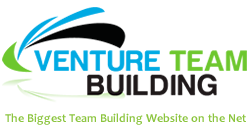To be effective people need to work together toward a common goal in a coordinated and cooperative way. Therefore you could say that team building is a systematic process designed to improve working relationships and team functioning such as problem-solving, decision-making, and conflict resolution that enables the group to overcome any goal-blocking barrier.
For many this result-orientated mission is the real purpose of team building. A team-building goal therefore could be simply to identify and develop effective communication.
Another way of looking at it is that team building is like coaching but for a collective group.
Why is Team Building Important?
Team Building formalises the power of collaboration among what otherwise might be excluded or often alienated individuals. For many team building is a way to blend talent, skills and the creativity of a group. With collaboration at its heart, team building improves cooperation, time and resource management for their benefit of an organisation or team.
The consequence is that effective team building produces better, faster results and provides a satisfying and motivating experience for team members.
Some reasons why team building is so important are:
- Most organisations are so complex and with de-layering there has to be team building for them to succeed.
- Everyone needs to be working towards common goals (that team building will generate and nurture) which need to be attainable and clearly communicated.
- Team building environments will outperform none team based environments.
Let us consider further why team building is so important – team building will make a favourable impact in six key areas:
Task Achievement
Teams are not designed for dealing with simple, repetitive tasks, as individuals will generally be quicker. However, team building comes into its own when faced with complex tasks, and associated problems, where probably there is no single, correct answer.
Quality of Decisions
Team building can generate more ideas than any one individual therefore, it has the choice of many possibilities before it and the ultimate quality of the decision is likely to be better than an individual’s decision.
Accuracy of Decisions
Judgments are far better through team building than through individual assessment of tasks that involve random error because team deliberation tends to purge ill-conceived notions and weak individual thinking.
Risk Taking
It has been shown that team building creates confidence to take greater, but measured, risks (and seize opportunities) than individuals would.
Motivation
Team building enhances morale and spurs individuals on to perform effectively at a higher level.
Speed of Learning
Team building creates a progressive, but nurturing, environment enabling team members to learn faster than individuals working alone.
Put more straightforwardly team building is important because it helps the group to capitalise on their strengths and minimise their weaknesses. The synergy that comes from team building can be very powerful.
Team Building Goals
For many organisations team building has become an integral part of their organisational strategy. Their specific team building goals are to provide team members with:
- Clarification of mission and vision
- Establishment of team member’s roles and responsibilities
- Faster start up for new teams or teams with new leaders
- Mechanisms for resolving conflict and elimination of dysfunctional behaviour
- An appreciation of differences in work styles and preferences
Team Building Roles
For team building to work the roles and duties contained within team working structures have to be determined.
Teams could, for example, be:
- A small group (typically 5 to 15 employees) that “owns” a distinct part of the process and whose members are flexible within the group
- Aware of its customer’s needs (both internal and external)
- The instrument for maintaining quality levels
- Responsible for its own housekeeping
- Left alone to undertake routine maintenance of plant and equipment
- Empowered to work out how its objectives fit in with the company’s mission
- Tasked with making decisions on issues affecting the group
- Trained in problem-solving techniques
- Responsible for safety issues
- Part of the selection process
- Self-determining on manning assignments and covering absent members
- Involved in the layout of plant and equipment
- Continually striving to improve the product, service and delivery process
What is the Team Building Process?
Everyone at work whether they are an operator or the Managing Director have worked with others in a team. Therefore all can express views on what constitutes an effective team building process. However, making team building succeed is often not as simple as it sounds. Problems with team building tend to be caused by team members who do not know very much about the team building process.
The task of team building is first to establish what the team was established to achieve. The team building process therefore must consists of all the things which go to make up how the team goes about achieving the task, and what influences it whilst doing so.
There are many aspects to this team building thinking and here are a few:
The Team Building Structure
If there are a large number of team members it is often difficult to get a reasonably fair discussion going. If there are too few there may be a series of silences. If some of the team members are of a higher status in the organisation than others, then this could be inhibiting discussion and therefore arrest the team building process. If there is insufficient expert knowledge in the team then opinions rather than facts will be offered which can often lead to arguments and therefore destroy the team building process..
The Nature of the Individuals
Differences in personality and mood often show up during team building – some people can’t seem to stop talking whilst others keep quiet, and others try to act as umpires or referees. All team-building discussions need to be controlled by the individuals and by a chairperson.
The Environment of the Team Meeting
The size of the meeting areas, their shape, heating, ventilation, lighting, seating, acoustics and decorations can all affect the efficiency of team meetings and therefore the team building process.
The Way Decisions are Made
For team building behaviour to take place, in a team meeting trying to reach a decision, then the communication process must cultivate listening and foster fairness if commitment and consensus and with it team building is to be realised.
A key to team building is that of creating a shared vision but that takes time and requires the full participation of all. If team members do not have a personal vision or lack confidence to it then team building will become difficult if not untenable.
Team Member Selection for Effective Team Building
To make team building effective team member selection is clearly very important. All too often team building is dismissed as the assembly of a group of individuals, calling them a team and telling them to get on with it. (This may explain why so many have difficulty getting the team building process to deliver the potential organisational benefits).
The essence of effective team building is that the members of the team work well together either as a group from the outset or initially simply compliment each other as individuals in which case the team building process will progress smoothly. The potential compatibility of any particular individual with the rest of the team is therefore critically important for team building to succeed. (Meredith Belbin has done much work in support of team building in the area of team roles analysis).
Individuals need to understand and learn the skills that make effective team building possible. Most know how to work independently or to give up uniqueness to aid team building, but to maintain some individuality during the team building process and subsequently during team working is to many too great an evolutionary step to take. Team members need to understand that team building succeeds with diversity and creativity. Try some team building activities and identify areas for improvement and team development.
Further Reading About Team Building
Over the years, we have published a number of bestselling books about team building and facilitation, as well as a comprehensive course. To learn more about our books and courses, please click here.





Hi there,
This is a very informative breakdown of team building!
So glad you found it useful!
Very good
Glad you liked it!
Thanks, David !!
In my opinion, team building is, in a nutshell, activities that are designed for mainly three purposes: encouraging teamwork for all the participants, improving social relationships between the team members, and define all the different roles of the participants. Commonly, these activities are designed with collaborative tasks as the core. Team building is also useful for managers and team leaders so that they can understand the strengths and weaknesses of each team member, among other benefits.
One of the most common team building activities is scavenger hunt, which naturally promotes all the purposes of team building activities, as well as encouraging the participants to be analytical. Various competitive team-based sports and games (including video games) are also relatively easy to implement. “Win, lose, or, draw”, or its variants is also a popular choice that is very easy to set up.
Mike Thanks for sharing your insights!
very helpful
Thanks!